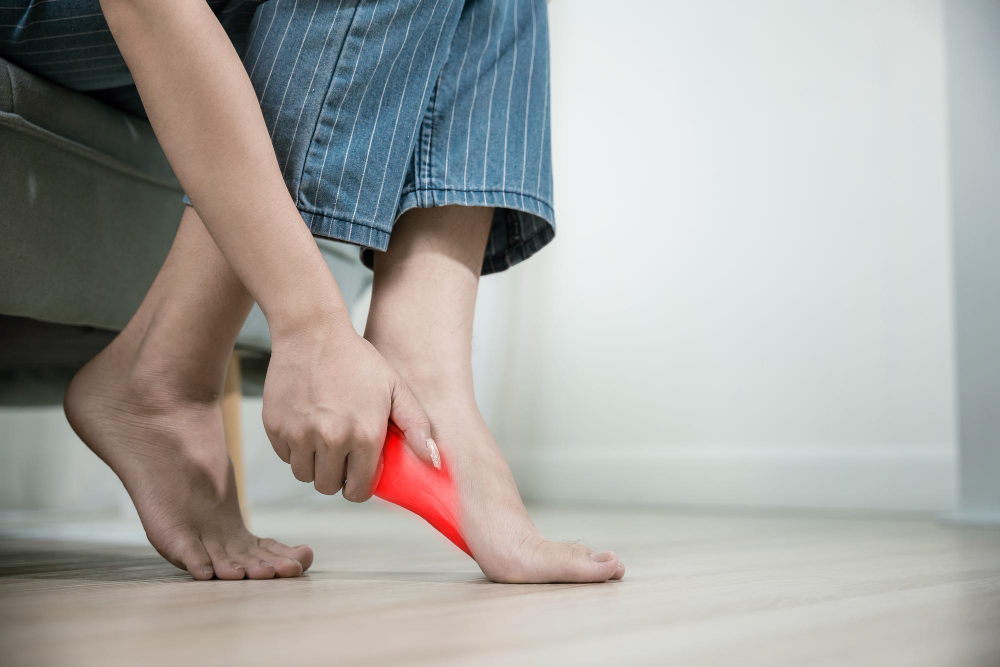

PLANTAR FASCIITIS

Plantar fasciitis is inflammation of the plantar fascia in your foot. It's the leading cause of heel pain. The plantar fascia is a strong fibrous attachment (akin to a ligament) that connects your heel to the ball of your foot and toes. It's as elastic as a thick rubber band that joins your foot's bones and produces the arch at the bottom. Plantar fasciitis develops when the plantar fascia is overworked or stretched too much. Anything that affects your plantar fascia can cause it to bulge. This inflammation makes walking and using your foot difficult. Most individuals have plantar fasciitis in one foot at a time, although it can happen in both.
Symptoms
The most common symptoms of plantar fasciitis are:
Heel pain.
Foot arch pain.
Stiffness.
Swelling on your heel.
A tight Achilles tendon.
Calcaneal spur buy overgrowth.
Inflammatory conditions like hyperuricem
Causes
Plantar fasciitis is caused by anything that irritates or damages your plantar fascia, such as:
Being on your feet all day at work.
Sporting activities.
Exercise or work on a hard surface (such as a warehouse floor or a sidewalk).
Exercise without stretching or warming up.
Wearing shoes that provide insufficient foot support (such as flip-flops or flat, flexible sneakers).
You can walk or stand barefoot at home.
Diagnosis
Plantar fasciitis is diagnosed by a physical examination by a healthcare provider. They will ask about your symptoms and examine your foot. They may lightly press on your plantar fascia to detect inflammation and assess your level of pain. Inform your provider about the pain you are experiencing in your everyday routine. Tell them where your foot hurts and when it is most uncomfortable during the day. A healthcare provider frequently diagnoses plantar fasciitis without the need for any tests. If they suspect that another problem or disease is causing the discomfort, they may perform imaging studies on your foot. Some imaging tests you may require include:
X-rays.
An ultrasound.
An MRI.
Treatment
Plantar fasciitis can normally be treated at home using over-the-counter (OTC) medications. To lessen the likelihood of recurrent plantar fasciitis, your healthcare professional will recommend solutions for alleviating your symptoms and supporting your feet. The most popular therapies for plantar fasciitis are:
Over-the-counter NSAIDs: NSAIDs (such as aspirin, ibuprofen, and naproxen) relieve pain and inflammation. Do not take NSAIDs for more than ten days in a row without consulting your doctor.
Rest: Take at least a week off from sports or the activities that caused the plantar fasciitis.
Icing your foot: Ice your foot for 10 to 15 minutes twice a day. Wrap a cold water bottle in a thin cloth to protect your skin before rolling it around the bottom of your foot to massage the soreness.
Wearing supportive shoes: Wear sturdy, padded shoes. Avoid wearing sandals, flip-flops, or other flat shoes that lack built-in arch support. Do not walk barefoot.
Orthotics or shoe inserts: You can put inserts in your shoes to provide extra arch support. Your provider will recommend either pre-made inserts available over the counter or custom-made orthotics fitted to the exact shape of your foot.
Immobilization: Wearing a walking boot (also known as a walking cast or pneumatic cam walker) for a few weeks will keep your foot in place and relieve strain on your plantar fascia. Your provider will tell you how long you'll have to wear a boot.
Massaging and stretching: Your healthcare physician or a physical therapist will demonstrate stretching and massage treatments for your foot and calf muscles.
Corticosteroids: Corticosteroids are medications that reduce inflammation. A corticosteroid, such as prednisone, may be injected into your plantar fascia by your healthcare professional.
Platelet-rich plasma (PRP): PRP is typically injected to help mend and repair damage.
Extracorporeal pulse activation technology (EPAT): EPAT is a type of shockwave therapy. Your provider will use concentrated acoustic waves (sound waves) to enhance blood flow to the plantar fascia, enabling it to heal quickly.
Percutaneous needle tenotomy: A percutaneous tenotomy involves inserting a needle through your epidermis and into your plantar fascia. Your body delivers more blood to the area than usual, enhancing your plantar fascia's ability to heal itself.
Plantar fasciitis surgery: Typically, the remedies indicated above are sufficient to alleviate symptoms and treat plantar fasciitis. It is quite rare to require surgery. The two most prevalent types of surgeries are gastrocnemius recession and plantar fascial release. Your healthcare practitioner or surgeon will advise you on the type of surgery required to treat plantar fasciitis.
Prevention
The best way to avoid plantar fasciitis is to keep your feet from overuse. In general:
Stretch before and after exercising.
Allow your feet to rest and recover after an intense activity or exercise.
Wear supportive footwear.
Do not walk barefoot on hard surfaces.
Replace your sneakers every six to nine months (or after 250 to 500 miles of walking or running in them).
If you have a health condition that increases your risk of developing plantar fasciitis, you may be unable to prevent it.
Plantar fasciitis can be painful and irritating, but with correct treatment and prevention, most people can control their symptoms and improve their quality of life. If you have recurrent heel pain, you should contact a doctor as soon as possible to avoid problems. Understanding the origins, symptoms, and treatment choices allows you to take the essential steps to manage and avoid plantar fasciitis while also maintaining healthy, pain-free feet.














